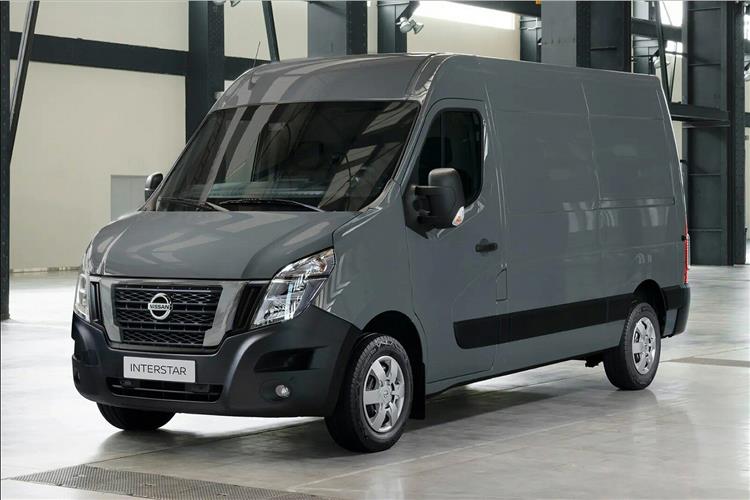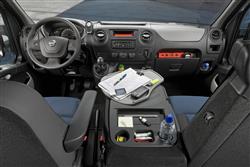INTER-STELLAR? (some text hidden) --NONE--
By Jonathan Crouch
Introductionword count: 77
Nissan rebadged the third generation version of the Renault Master to give itself a contender in the large van segment between 2010 and 2024. The resulting product was first called the 'NV400', then the 'Interstar'. Either way, you've got all the attributes of a Master but perhaps at a slightly more appealing price. As with the Master, there's a huge choice of body styles, load volumes and options, plus an efficient set of Euro 5-compliant diesel engines.
Modelsword count: 5
Large-sized van (2.3 CDTi diesel)
Historyword count: 339
By this century's second decade, Nissan was unveiling big plans for vans. Previously a minor player in the LCV sector, the Japanese company's influence in this segment had been slowly growing through the Noughties, culminating with the well received launch of the compact but surprisingly spacious NV200 model in 2010. That NV200 was Nissan's own work, but the brand returned to its traditional partner Renault for help in developing the most sizeable model in its LCV range, this vehicle, which from launch in 2011 was badged the 'NV400' before early in the next decade being rebadged as the 'Interstar' (the name used for the previous generation pre-2011-era model). What we were offered here was Nissan's version of Renault's Master (a design which back in 2011 was also shared with Vauxhall's Movano). All three makers were targeting key players in the segment for the largest size of working van. That meant LCVs like bigger Ford Transits, the Iveco Daily and, perhaps most notably, two models that back then were dominating this part of the European market. First there was Mercedes Sprinter and Volkswagen Crafter shared design. And up against it was the design variously badged as either the Fiat Ducato, the Citroen Relay or the Peugeot Boxer. In short then, there was plenty of competition. But this Nissan was well equipped to meet it. If you've tried the Renault or the Vauxhall versions of this design, then you'll already know that it's a very competitive platform indeed, up with the class leaders when it comes to practicality and running costs. To this, this Nissan added sharp pricing, distinctive looks, a huge range of model options and some clever hi-tech gadgetry. Packing up this big LCV is no small task, given loading capacities of anywhere between 8 and 18m3 in standard van models. And that torquey 2.3-litre dCi engine can haul big weights too - up to 4.5-tonnes, if you're really piling on the pounds. Could a used version of this big Japanese LCV contender be for you? Let's find out.
What You Getword count: 771
Aware that they would need to share Renault and Vauxhall underpinnings for this model, Nissan went to particular trouble to style their version differently - and sure enough, this NV400 does have a distinctive look. The styling was completed at Nissan Design Europe in Paddington and engineered by Nissan's Technical Centre in Bedfordshire, so there was a distinctly UK-based approach to the whole thing. A thick bumper adds aggression to the front end, curling up at the edges to protect the corners from knocks. There are also useful steps cut into the front bumper so that owners can get a leg-up when cleaning the windscreen. Side rubbing strips are a boon along the flanks too. And inside? Well, the cabin isn't anything too exciting, but the stubby gear lever that sprouts from the fascia falls nicely to hand amidst the usual sea of tough and durable elephant grey plastics. There isn't quite the same kind of soft touch, granite build quality you'd find in more expensive Volkswagen or Mercedes rivals but fit and finish has certainly improved over what was provided in the previous generation Interstar and what this model lacked in tactile feel, it more than made up for in practical touches. Both seat and wheel can be height-adjustable and there's a minefield of storage options inside the cab (150 litres in total), from the usual door bins, overhead shelf, cup holders, chilled glove boxes and cubby holes to compartments for laptops and sunglasses, plus an optional clipboard that folds out of the dash for holding invoices, maps or delivery notes. This LCV had a bigger cab than anything Nissan had previously provided in this segment, which meant that this model could provide comfortable room for three, though the centre seat passenger's space is still rather narrow with kneeroom slightly compromised by the cupholders and storage provided by the two centre-mounted bins. Since most of the time the central berth won't be occupied, you can fold it down and use it as a table, complete with cup holders. Not quite so neat is the positioning of the grab handle you grasp on entering the cab, stuck above the door opening rather than being more naturally placed on the A-pillar. Which shouldn't detract from the fact that overall, this is a beautifully thought out cabin. Highlights include optional touches like the huge, split storage area under the passenger seats, accessible simply by flipping up the cushions. Then there's the way the centre seat backrest folds down to create a table that uniquely swivels towards the driver. And the sat nav screen that folds out of the roof, incorporates real time traffic information to guide you round jams and includes MP3 and Bluetooth compatibility. Right, let's look at the practicalities of running this Nissan. Operators will be choosing between four body lengths - L1, the L2 model, L3 and L4: and three roof heights - H1, the H2 variant and H3. That means a wide range of cargo capacity choices - anything from 8 cu.m and 2,583mm of load space length in the base L1 H1 variant, right up to 17.0 cu.m and 4,330mm of load space length in the very biggest L4 H3 model, which can swallow up to four euro pallets. With the volume mid-range L3 H2 body shape, there's a 12.3 cu.m cargo capacity and 3,083mm of floor length. Interior cargo bay roof height varies between 1,700 and 2,144mm, depending on the roof option you've selected and whether you've gone for front or rear wheel drive. All models feature a load area width of 1,765mm - which on single rear wheel models narrows to 1,380mm between the wheel arches. There are four 'GVW' Gross Vehicle Weight options offered to operators - 2.8, 3.3, 3.5 or 4.5 tonnes. And the possible payloads can be as much as 2,167kgs but of course that again will vary according to your choice of variant. A typical L3 H2 model can take up to 1,384kgs. As for running costs, well updates to this model's 2.3-litre dCi biturbo diesel engine in 2019 made a big difference to running costs. The 150PS version of this unit was 17% more frugal (the WLTP combined cycle fuel reading is up to 47.9mpg); and around 13% cleaner (the NEDC-rated CO2 reading is 156g/km). With, say, a L3 H3 150PS Master model, Nissan reckoned this would save an operator £303 over a four year / 80,000 mile operating period. And further savings would be accrued through the fact that with later versions of this model, servicing intervals were extended to every 25,000 - or every two years, whichever comes first.
To see the full road test text contact us on 0330 0020 227
Pictures (high res disabled)

.jpg)
|
.jpg)
|
.jpg)
| |||
.jpg)
|
.jpg)
|
.jpg)
| |||
.jpg)
|

|
Scoring (subset of scores)
Category: Vans
| Performance | |
| Handling | |
| Comfort | |
| Space | |
| Styling, Build, Value, Equipment, Depreciation, Handling, Insurance and Total scores are available with our full data feed. | |



